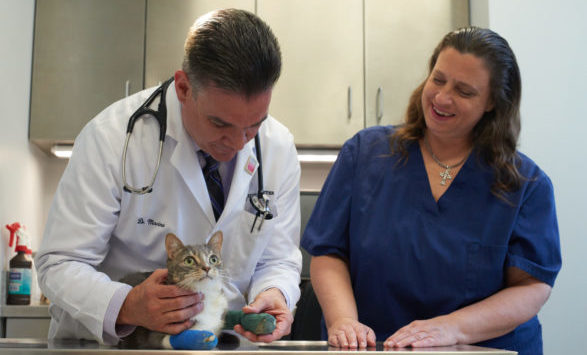Hot Spots on Dogs

Background
Hot spots, also known as acute moist dermatitis, are itchy, red lesions that develop when a dog repeatedly licks or scratches at an area on his skin, creating a warm, moist wound. Hot spots most commonly develop at the base of the tail, outer thighs, neck, or face, and may seem to appear out of nowhere.
Risk Factors
Your dog is more likely to get hot spots if he has allergies, fleas, or other skin parasites, or frequent ear infections.
A hot spot can develop in any dog, but are more common in breeds with dense undercoats, including:
- German shepherds
- Golden retrievers
- Labrador retrievers
- Saint Bernards
Signs
- Loss of fur around irritated area
- Redness, warmth, and moisture around affected area
- Irritated area may be painful to touch
Diagnosis
Diagnosis is based on the appearance of the lesion and the frequency of scratching. The location of the lesion may help narrow down the suspected cause. For instance, lesions near the tail are most often due to fleas.
Treatment
If your dog’s hot spots are a symptom of some other underlying issue such as allergies, your veterinarian will treat that issue.
If the hot spot is not allergy-related, the area around the hot spot will be shaved down to make medicating and cleaning the hot spot much easier. Once cleaned, your veterinarian may prescribe an antibiotic or a steroid if the hot spot is bacterial. If not, your veterinarian may instruct you on the best way to clean the hot spot until it heals. Your dog will likely need to wear an Elizabethan collar to prevent him from further traumatizing the red, raw skin and to give it a chance to heal
Serious hot spots may need antibiotics for successful treatment. If allergies are the underlying cause of the hot spot, treatment for allergies may also be necessary.
Prevention
Giving your dog the proper flea and tick treatment is important for preventing scratching and licking.
If your dog has long hair, it’s important to brush it and keep it clean. If your dog’s fur gets matted, bacteria can grow underneath the mat, causing an infection, which leads to licking and scratching.
Dogs who are bored or anxious also may lick or scratch to the point of developing a hot spot, so providing a calm, enriched environment for your dog is key.
If you notice your dog repeatedly licking one area of his skin, check under the fur and make sure a hot spot isn’t developing.
Make an Appointment





























